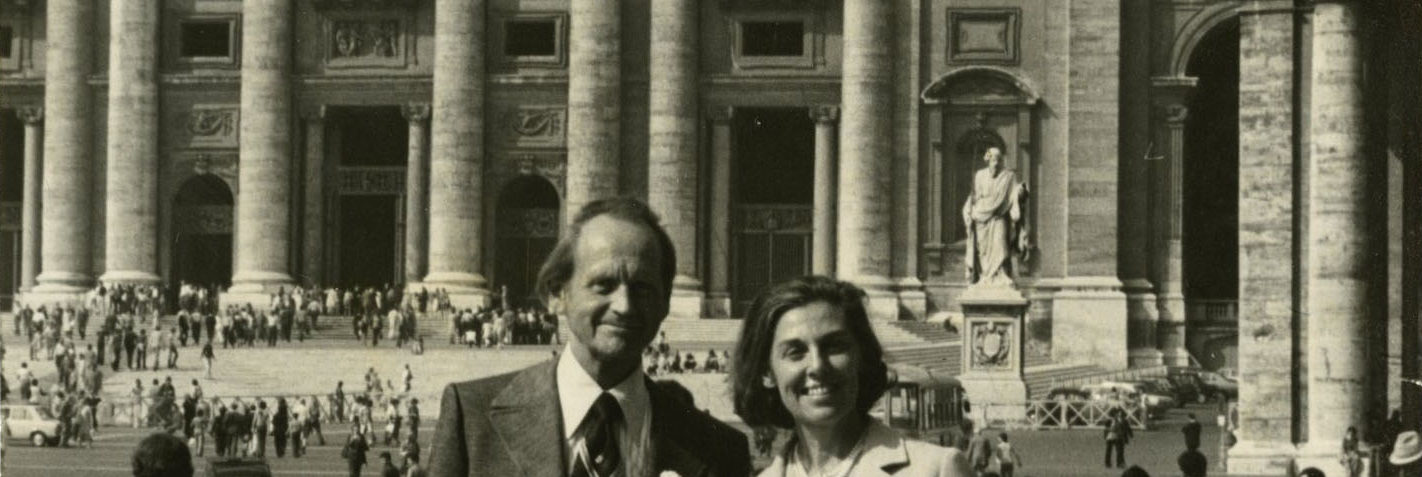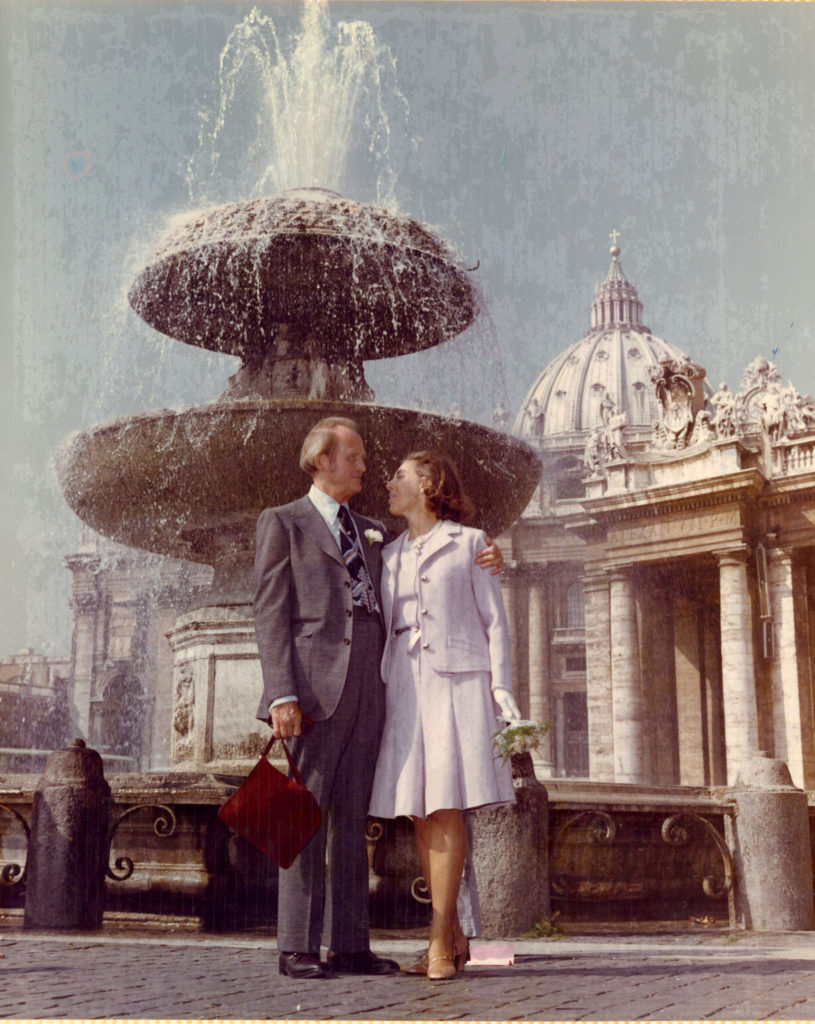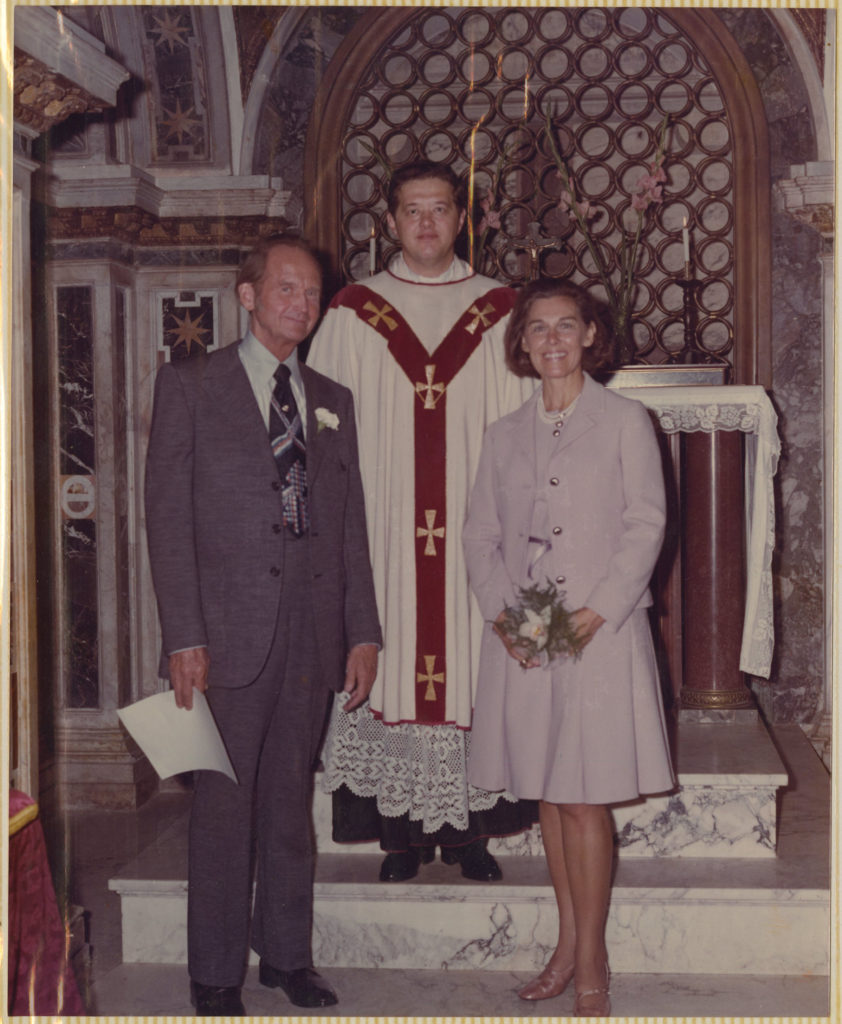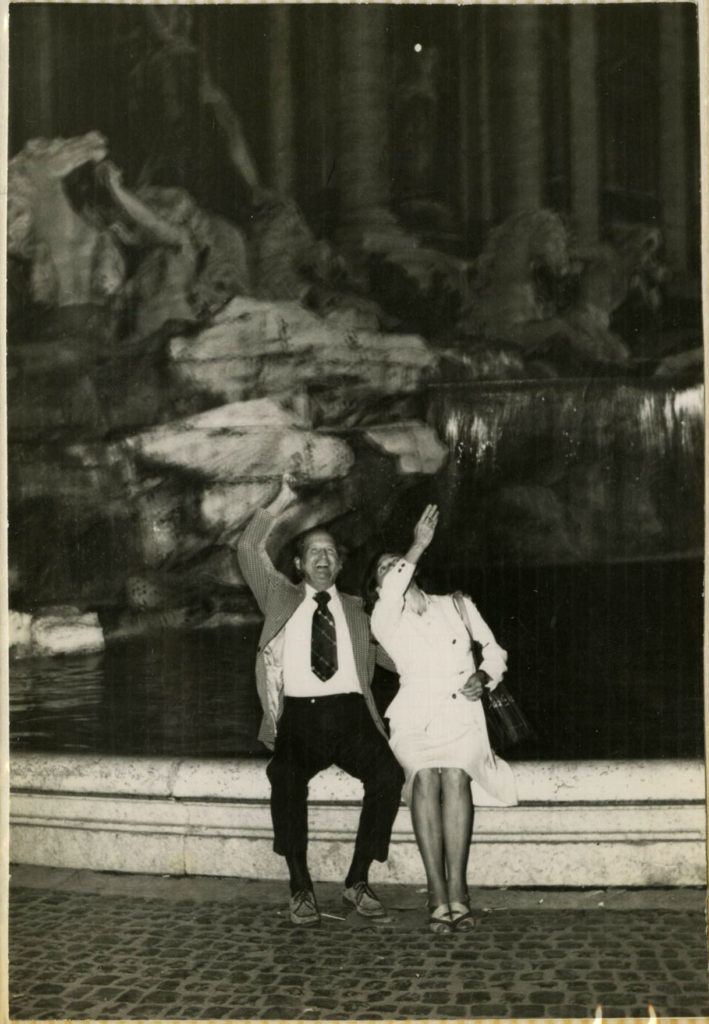Titled “A Love Story”, this journal begins Sybil’s travel writing experience. Aptly named, the biggest highlight of this journal is Sybil’s marriage to Cliff inside St. Peter’s Basilica. As this is the first of her travel writings, we can learn from this journal what her strongest influences were as well as her first stages as a developing travel writer.
Sybil traveled to Rome several days before her wedding in order to make all the arrangements necessary. Her clothing, rehearsal dinner location, reception location, invitations, and rings were all decided and finalized once she arrived in Rome. To her, all of these things were small needed details adding up to a big event. To Sybil, getting married steps away from the tomb of St. Peter was truly the reason she traveled. As you will read, Sybil’s prime influence for her travels, in addition to her love of art, was her love of her faith.
Sybil first arrived in Rome alone. Unlike many early women travel writers, the later twentieth century offered more equality to female travelers than ever before. Instead of traveling with a husband, sibling, or staff, an evolution of female travelers traveling un-chaperoned emerges. Sybil is a prime example. What should be noted, here and throughout every journal, is how Sybil was able to travel the way she did. As the widow of a judge and the fiancé of a well-respected doctor, Sybil had access to funds the average American female would not. We must remember that due to her privilege she was able to travel however, wealth was not a prime influence in her travels as we can see in her choices of location and the activities she partakes while traveling.
Upon first entering Rome, Sybil met her daughter, Ellen, who was studying in Rome at the time. Because of the help of her daughter, Sybil was able to bypass the language barrier in most situations while in Rome. That being said, Sybil makes a personal effort to learn Italian, as reflected on in her journal, “Buon giorno, buon sera, come sta, all day long.”
As Sybil and her daughter trek through Rome to arrange a wedding, Sybil falls in love with a French restaurant near the Pantheon named L’Eau Vive. This restaurant is run and operated completely by missionary sisters from all over the world. Despite the beauty and elegance of their reception location, Casina Valadier, an exquisite and expensive restaurant located on a hill overlooking all of Rome, it was the small French L’Eau Vive that she favored because of their connection to the Catholic church as well as the impact the missionary sisters made. Even in her later travels back to Rome she specifically visits L’Eau Vive to relive her memories and visit with the French-speaking nuns. This appreciation for a restaurant that embodies charity and the church speaks to her influences of love and kindness, love in her love for her faith, which is represented in this restaurant and kindness in the charity the nuns of this restaurant live by.
The day before the wedding is historically memorable, as she points out in her writings, because of a meeting between the Pope and the Italian president for the first time. Due to their meeting, crowds in the Vatican are sectioned off. Sybil and Cliff, mixed into the bedlam are also there to get their marriage papers signed.
Finally, on September 23, 1972, Cliff and Sybil are married in the Clementine Chapel, which sits directly next to the tomb of St. Peter. The couple opted for a very small audience, as the chapel itself would only be able to fit a small group. Sybil’s daughters Ellen and Candace attend as witnesses, in addition to the family Ellen was staying with. All in all every member present for the wedding was able to fill a small table on the balcony of the Casina Valadier, overlooking Rome. Sybil specifies that the view of St. Peter’s Basilica was particularly what caught her eye. What should be mentioned about Sybil’s wedding is that the Clementine Chapel is not an open area for visitors. Even as the ceremony takes place she mentions that spectators “peer through the locked iron grill” that separates the chapel from the rest of the area underneath the main alter level. Even today the chapel is inaccessible without special access. To get married in this location meant you not only had to have special access to the chapel but you had to have a very deep connection with the church. For Sybil, getting married steps away from the remains of St. Peter was the ultimate proof of her unyielding faith. She wanted, more than anyone, the presence of the church to shine through the strongest in her life.
Moving forward to the honeymoon, Sybil and Cliff enjoyed a honeymoon encompassing several different locations. Their first stop is the North African city of Tunis. It is in her first descriptions of Tunis that Sybil’s thoughts and ideas of travel really start to come to the surface. Tunis itself is not the typical honeymoon destination. French occupation had left the country merely a decade before and although the recent economy boost meant more tourism, it wouldn’t be considered the most romantic destination of 1972.
Sybil describes Tunis as “exotic and colorful…different as night and day from the rest of the world.” Given that Sybil is a white American, she travels under the effects of Western colonization from the colonizer standpoint. By describing Tunis as different from the rest of the world, she implies that it is something other than the Western norm. We can see here her attempt to be neutral, instead of expressing orientalism, or a European Western supremacy in standards. As she continues to describe what she means by “exotic and colorful”, we can tell she holds a great appreciation for the location she is visiting. Beginning here in this trip to Tunis, Sybil has started to develop her outlook on other cultures. She chose to highlight the beauty in the countries she visited, spotlighting the goods that could be bought, the music one may hear, and the food she enjoyed. By taking this route of description in her writings, Sybil acts from both inside the colonizer gaze and outside of it, inside by comparing the differences to a Western designated norm and outside by deviating from what she considers the norm to enjoy and appreciate the culture already established in that location.
In addition to her general experiences, Sybil made the biggest effort to visit as many churches and museums possible. She tried to attend mass as often as possible, not only for her dedication to faith but because so many of the churches she visited contained such beautiful decoration. A true art admirer, Sybil spent hours around art even on her honeymoon. Her dedication to art and the church speaks as her biggest influences.
Before leaving Tunis, Sybil mentions that at night, there is not a single woman on the streets. As a tourist, her privilege allowed her to be exempt, however she still operated under the gendered rules of Tunisia. Her night privilege only existed due to her husband traveling with her. This experience reminds us how dangerous traveling still was in certain areas, especially for women.
From Tunis, Sybil and Cliff run into a minor medical issue concerning a cholera outbreak and are forced to Florence, Italy. In the next week, Sybil and Cliff visit historical sights such as Napoleon’s hide out on Elba Island, the tower of Pisa, more museums, and yes, more churches.
On October 4, Sybil ends her Wedding journal by making a quick stop by the Trevi Fountain and then the couple flies off to Paris.
What we learn from this journal, other than experiences unheard of, is Sybil’s development into a travel writer. She starts small, pointing out general experiences mixed with an admirable description of foreign destinations. Through her first journal we can understand how important faith and art was to Sybil, shaping her influences and interests for future travel as well as her role as a Western traveler and how she operates both in and out of the gaze of colonization.



